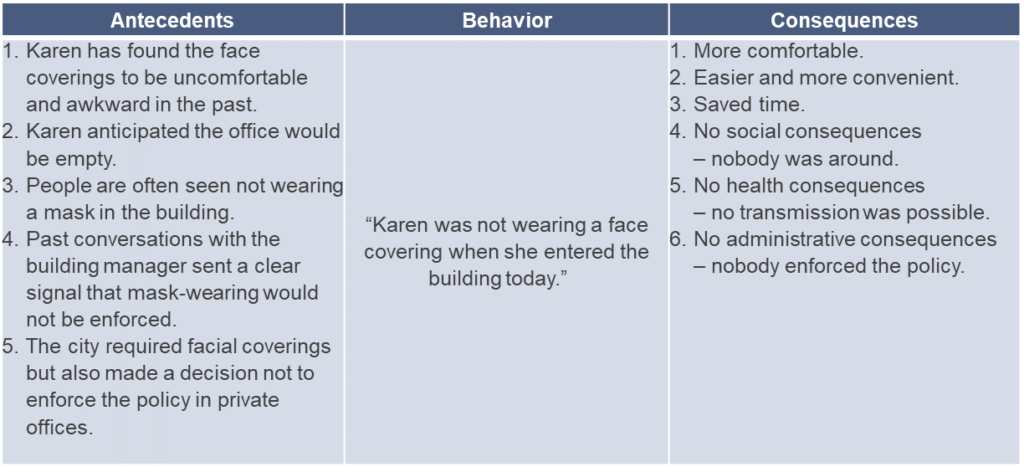August 13, 2020
ABC Analysis
Here’s a 5-step method for an ABC analysis, with an example.
Step 1
Pinpoint a single action that you want to change. Be extremely specific. Think of a specific person, at a specific point in time, in a specific situation.
Step 2
Identify as many antecedents that were present in that specific situation. Antecedents are signals, events, and cues that triggered the person to do what they did. Reminders, email, conversations, signs, training and rules are all common attempts to trigger behavior in organizations.
Step 3
Identify as many consequences that were in play in that specific situation. A consequence is an experience that follows behavior and affects the chance the behavior will occur again in a similar situation.

Step 4
Evaluate the impact of the consequences on the person. Positive consequences encourage the behavior to continue into the future. Negative consequences discourage it1. In either case, consequences are most powerful when they happen right away and when they are meaningful to the person.
Step 5
Create a plan for change. This is where leadership decision making becomes essential and critically important. In the above example, the only consequences affecting Karen were soon, certain, and positive. Unless something changes, it is very likely that Karen will continue not wearing her face covering in the office building. Leaders have the opportunity to create such a plan.
The plan starts with repeating the above ABC analysis on the desired behavior. In this case, maybe the desired behavior is for Karen speak up about a policy that makes no sense. Then we can change the antecedents and consequences: The goal is to create a situation in which the desired behavior is more likely to occur, and the undesired behavior is less likely to occur.
Has leadership decided to provide the proper facial covering and make it easily accessible? Has leadership conveyed the value for wearing the facial covering, in a compelling and positive way? Are leaders wearing facial covering reliably? Do leaders acknowledge employee use of facial protection? Do they give firm guidance when necessary?
Most importantly, do leaders own the impact their decisions and actions on the behavior of the worker? Or do they blame the worker?
Further Reading
Krause, T. R., & Bell, K. J. (2015). 7 insights into safety leadership. Ojai, CA: Safety Leadership Institute.
Krause, T. R. (1997). The behavior-based safety process: Managing involvement for an injury-free culture. New York: John Wiley.
Footnotes
- Behavioral scientists have a very specific technical definitions for “positive” and “negative.” We are using the colloquial meanings here, not the technical ones.


